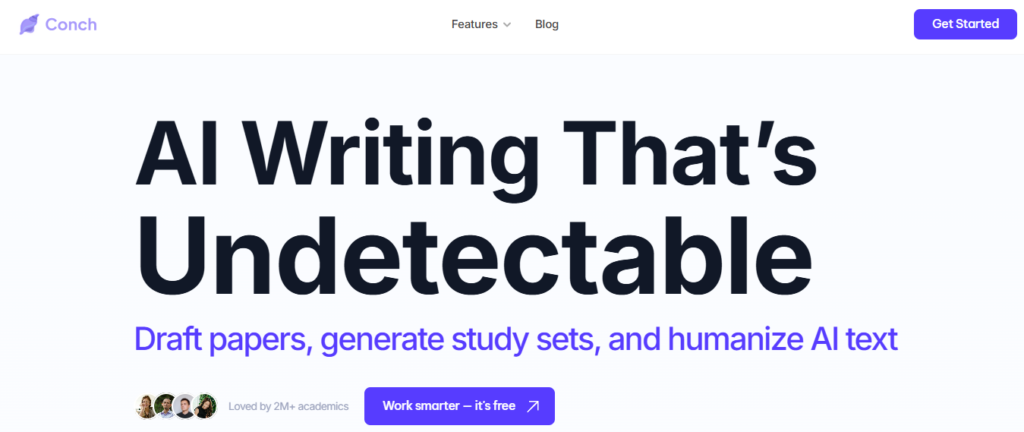Writing a proposal essay can feel overwhelming. First, you need to choose a topic and narrow it down. Then, you have to conduct research and develop a clear thesis or argument. Finally, you need to organize your findings and write the essay. Proposal essay examples can help you tackle your assignment with confidence. If you’re feeling the pressure of an upcoming deadline, you might even want to learn how to use AI to write a paper.
With AI, you can brainstorm ideas, create an outline, and even draft sections of your essay. In this guide, we’ll walk you through the value of proposal essay examples, so you can quickly and confidently learn how to write a compelling proposal essay by seeing clear examples and step-by-step tips.
A helpful tool to have as you learn to write a proposal essay is Conch AI’s writing assistant. This easy-to-use AI writing tool can help you achieve your goals, like quickly and confidently writing a proposal essay by showing you clear examples and offering actionable tips.
What is a Proposal Essay?

A proposal essay introduces an idea and a plan to address a particular issue. It clearly defines the problem and then offers a practical solution. The goal is to convince the reader that the solution is both needed and achievable. Unlike a persuasive essay that focuses on why a topic is essential, a proposal essay focuses on what should be done about the issue.
It explains the steps to make it happen. For example, imagine you notice that your local library struggles with low attendance. A proposal essay might suggest creating community events at the library, detail how these events could be organized, and argue why they would attract more visitors. Proposal essays are popular in education because they challenge you to think critically and develop realistic plans.
They require you not just to point out problems, but also to propose workable solutions. A well-crafted proposal essay demonstrates thorough consideration of the issue and convinces the audience that the proposed idea is both meaningful and feasible.
Related Reading
- How to Calculate H Index
- How to Write an Informative Essay
- Technology Essay
- How to Write a Header for an Essay
- How to Write a Biography Essay
- How to Write a Reflection Paper
- How to Write an Encyclopedia Entry
- Speech Analysis Example
- What is a Good H Index
Proposal Essay Examples

Proposal essays identify problems and offer well-reasoned solutions supported by evidence. Below are original examples modeled after common structures found in credible proposal essays, demonstrating how clear problem statements and practical proposals can be effectively communicated.
1. Enhancing Urban Green Spaces for Community Well-being
Introduction
The rapid expansion of cities has drastically reduced green spaces, negatively affecting residents’ mental health and local ecosystems. Urban green areas offer numerous benefits, from purifying the air to promoting social cohesion. This proposal outlines a plan to expand and improve green zones in metropolitan areas.
Problem Statement
Current urban development often prioritizes infrastructure over parks and green spaces, diminishing residents’ access to natural environments and reducing biodiversity. This imbalance leads to increased stress, poorer air quality, and loss of urban wildlife habitats.
Proposal
- Collaborate with city planners to identify underused lands for transformation into parks, community gardens, or green corridors.
- Allocate municipal funds and encourage private partnerships to develop and maintain these spaces.
- Launch community-driven planting and stewardship programs to engage residents.
- Incorporate green rooftops and vertical gardens into new and existing buildings.
Conclusion
Expanding urban green spaces delivers multiple benefits, including improved health, environmental sustainability, and stronger communities. By adopting these measures, cities can foster resilience and enhance the quality of life amid growing urbanization.
2. Combating Youth Cyberbullying with School-Based Programs
Introduction
Cyberbullying is a pervasive problem that affects students’ psychological well-being and academic performance. This essay explores how schools can proactively prevent and reduce cyberbullying through targeted interventions.
Problem Statement
With increasing online engagement among youth, cyberbullying incidents have escalated, causing anxiety, depression, and even suicidal ideation among victims.
Proposal
- Implement comprehensive anti-cyberbullying curricula involving workshops, role-playing, and digital citizenship education.
- Train staff and teachers to identify and respond promptly to reports of cyberbullying.
- Establish anonymous reporting systems to encourage students to speak up without fear of retribution.
- Engage parents through informational sessions that emphasize prevention and open communication.
Conclusion
School-centered programs provide a direct and effective method for combating cyberbullying. Proactive education and supportive environments can create safer spaces for all students within schools.
3. Promoting Renewable Energy Adoption in Small Businesses
Introduction
Small businesses contribute significantly to energy consumption, yet they often lack the resources to transition to sustainable options. Increasing renewable energy use in this sector is crucial for reducing carbon footprints and promoting sustainability.
Problem Statement
Financial constraints and limited awareness hinder many small enterprises from adopting renewable technologies such as solar panels or energy-efficient appliances.
Proposal
- Create government grant programs to subsidize initial investments in renewable energy infrastructure.
- Launch informational campaigns outlining long-term cost savings and environmental benefits.
- Facilitate partnerships between renewable energy providers and business associations for discounted services.
- Develop a recognition program to highlight businesses embracing green energy, encouraging others.
Conclusion
By supporting small businesses with financial incentives and education, the adoption of renewable energy can be significantly increased, benefiting both the environment and local economies.
Related Reading
- Essay on Respect
- Essay About Bullying
- Why I Deserve This Scholarship Essay
- Is Census Data Primary or Secondary
- Is a Documentary a Primary Source
- Are Textbooks Primary Sources
- Essay About Death
- How to Write a 4 Paragraph Essay
- Finance Research Paper Writing
Writing the Structure of a Proposal Essay

Crafting a proposal essay requires a clear and organized structure that guides your reader from understanding a problem to embracing your solution. Below is a step-by-step outline to help you build a compelling proposal essay.
1. Introduction
Start by grabbing the reader’s attention with an engaging hook. This could be an intriguing fact, question, or scenario. Then, clearly and concisely introduce your central thesis or proposal.
Example
“Many city dwellers struggle with limited green spaces, negatively impacting mental health; a community garden initiative could transform urban living.”
Think of the introduction as setting the stage, providing context, and preparing your audience for what’s to come.
2. Problem Statement
This section zooms into the problem at hand. Clearly define what the issue is, who it affects, and why it demands immediate attention. Avoid vague generalizations; be specific and focused.
Answer These Key Questions
- What exactly is the problem?
- Why should the audience care?
- What might happen if nothing changes?
Example
“Residents in urban neighborhoods face rising stress levels due to lack of accessible parks and green spaces, contributing to mental health challenges and decreased community engagement.”
3. Proposed Solution
Here, present your proposed idea as the direct answer to the problem. Focus on articulating your recommendations, rather than detailing every operational step.
Think of this as presenting a blueprint. You show the design, not the construction process.
Example
“Establishing community gardens in vacant lots can provide residents with relaxing green spaces, foster social connections, and improve mental well-being.”
4. Implementation Plan
Explain how your solution could be realistically put into practice. Be practical and succinct.
Key Points
- Who will be responsible?
- What steps need to be taken?
- How long will the process take?
Example
“Local government, neighborhood associations, and volunteers will collaborate to identify sites, prepare soil, and plant gardens. This project can be initiated within six months, starting with pilot gardens.”
5. Expected Outcome
Illustrate the positive changes your solution would bring about. Paint a clear picture of success.
Example
“If community gardens are established, urban residents may experience reduced stress levels by 30%, improved air quality, and stronger neighborhood bonds.”
6. Evaluation
Demonstrate thoughtful consideration by acknowledging potential limitations, required resources, or trade-offs.
Discuss
- Estimated costs
- Time commitments
- Stakeholders involved
- Possible risks or challenges
Example
“While initial funding is required for soil and plants, community fundraising and grants can offset costs. The project may face challenges such as maintenance needs or space restrictions, but these can be managed through volunteer schedules.”
7. Conclusion
Conclude by reaffirming your proposal’s significance and potential impact. Your closing should be convincing yet realistic, leaving readers inspired to support your idea.
Think of this as the final pitch. Summarize your vision without repeating every detail, and reinforce why it deserves consideration.
How to Write a Proposal Essay with Conch AI

Writing a persuasive proposal essay becomes much easier and faster when you leverage the powerful capabilities of Conch AI. This tool helps organize your ideas, generate well-structured outlines, and produce sentence-level suggestions while retaining your writing style. Below is a step-by-step guide on how to create an effective proposal essay using Conch AI.
1. Launch a New Document
Begin by opening Conch AI and starting a fresh document. This clean slate environment helps you focus entirely on bringing your proposal ideas to life without distractions. Just like other AI writing assistants, Conch AI’s user-friendly interface ensures you can navigate quickly to start your project.
2. Use a Specific Prompt to Guide Your Essay
Input a detailed prompt that clearly outlines the topic and the elements you want your proposal essay to cover. For example, you might enter:
“I want to write a proposal essay introducing a campus-wide textbook rental program, covering the problem, solution, cost breakdown, and timeline.”
This approach helps Conch AI understand your goal and tailor the essay structure accordingly.
You can choose between different heading styles:
Smart Headings
Automatically generates sections such as Introduction, Problem, Proposed Solution, Implementation, and Outcome, perfectly aligned to classic proposal essay formats.
Standard Headings
Opt for the traditional introduction, body, and conclusion format if you prefer a straightforward approach.
3. Initiate Writing and Generate an Outline
After setting your prompt and choosing heading style, click Start Writing. Conch AI immediately drafts a working title and a rough outline crafted explicitly for your proposal. This outline ensures that your essay has a logical flow, making it easier to build your argument step by step.
As you begin typing, Conch AI remains active, offering suggestions for sentences and phrases. You have complete control to either accept these suggestions to speed up writing, edit them to fit your tone, or skip if they don’t match your style.
4. Expand Sections with AI Assistance
With your proposal outline in place, proceed to enrich each part of the essay. Conch AI’s sentence-level recommendations help you articulate your ideas clearly and precisely. These suggestions are designed to save time and reduce writer’s block without diluting your unique voice, so the essay remains authentic and persuasive.
This method eradicates the challenge of facing a blank page and maintains steady progress toward a polished final draft.
Let’s Talk About Conch AI Writing Tool
Join millions of students to write papers and ace exams with Conch AI’s AI writing tool. We built this tool because we were tired of spending endless hours on citations, study guides, and rewrites. Unlike general AI tools, Conch understands what students need – instant citations that professors accept, stealth writing that bypasses detection, and study tools that help you learn the material.
Our Chrome extension brings these superpowers directly to your research workflow, while our lecture recording feature takes notes for you, allowing you to focus on understanding the concepts. Try our free plan today and see why students tell us they’re saving 10+ hours a week with Conch AI. When you’re ready for unlimited access, our Limitless Plan gives you everything you need to transform your academic experience. Join over 2 million students and ace your classes with our AI writing tool!
Related Reading
- Ai Annotated Bibliography
- Leadership Essay Examples
- Social Media Argumentative Essay Topics
- Topic Sentence vs Thesis Statement
- Evaluation Essay Examples
- National Honor Society Essay Examples
- Diversity Essay Examples
- Literary Analysis Essay Examples
- Informative Essay Topics
- Dyslexia Writing Examples
Join Over 2 Million Students and Ace your Classes with our AI Writing Tool
While many AI writing tools can help you write a paper, Conch AI is specifically made for students. We understand what you’re going through, and we’ve built our AI tool to help you navigate it. For instance, we know you need instant help with citations to avoid losing points. Conch enables you to write better papers and ace exams so you can stop stressing out about school.

Leave a Reply